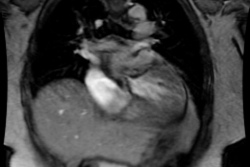Truncus Arteriosus:
Clinical:
Truncus is an uncommon congenital heart disorder (2% of CHD) which is due to a common aorticopulmonary trunk (a single arterial vessel that arises from the heart and supplies the systemic, pulmonary, and coronary circulations [5]- the result of failure of division of the primitive common truncus arteriosus into an aorta and pulmonary artery by formation of the spiral septum. The conal septum is usually absent and a malalignment VSD is present in almost all patients- typically an associated large, high riding VSD [5]. An ASD may also be identified in about 20% of cases. The common truncal valve typically has 3 cusps (70% of cases), but this can vary from 2 to 6. Stenosis (in 33% of cases) or insufficiency (in 50% of cases) of this valve may also coexist. Anomalies of the coronary ostia of the coronary arteries (which arise from the common trunk) are also common. Because of the large VSD, right and left ventricular pressures are equal. The right ventricle becomes hypertrophied and enlarged. Because the aorta and pulmonary arteries arise from the same truncal vessel, they have the same systolic pressure. The pulmonary flow is increased and the pulmonary arteries become enlarged. Interestingly, the streaming of blood through the VSD occurs in such a manner that blood from the right ventricle flows predominantly to the pulmonary arteries and blood from the left ventricle flows predominantly into the aorta- this accounts for only mild cyanosis [1].Patients typically present with CHF in infancy (age 2 to 3 weeks) and a widened pulse pressure. Cyanosis is mild. Associated abnormalities include a right aortic arch (35% of cases), an interrupted aortic arch (11-20%), persistent left SVC (10% of cases), skeletal anomalies/cleft palate, unilateral renal hypoplasia or agenesis, absent gallbladder, and hypoplastic lung. DiGeorge syndrome occurs in as many as 33% of cases [1]. There is also an association with chromosome 22q11 deletion [5]. Surgical correction is usually undertaken within the first few weeks after birth [5]. Treatment consists of closing the VSD and disconnection of the pulmonary trunk from the ascending aorta with patch closure and restoration of continuity between the right ventricle and pulmonary vascular bed with a valve conduit graft implantation [2]. In the Rastelli procedure the pulmonary outflow tract is reconstructed via a RV to pulmonary artery synthetic graft.
There are 4 types of Trucus based on the origin of the pulmonary arteries:
Type 1: (50%) A common truncal vessel gives off a well formed main pulmonary artery which bifurcates into right and left pulmonary arteries. The main pulmonary artery typically arises from the left-posterior aspect of the truncal vessel. A main pulmonary artery segment may still be identified on CXR. On angiography one will identify simultaneous filling of the aorta and pulmonary arteries.
Type 2: (25%) Separate left and right pulmonary arteries arise directly from the dorsal (posterior) surface of the ascending truncal vessel. The origins of the vessels are closely spaced to each other. Occasionally there is peripheral stenosis of one of the pulmonary arteries- this results in asymmetric blood flow on the frontal CXR. In this type of truncus the pulmonary arteries must descend to reach their respective hila- referred to as the "Waterfall" sign on angio (also seen in type 3).
Type 3: Separate left and right pulmonary arteries arise from the lateral surface of the ascending portion of the truncal vessel. Again, there may be associated peripheral stenosis of one of the vessels.
Type 4: Pseudotruncus (or severe Tetralogy of Fallot): Due to pulmonary conal agenesis, not failure of truncal septation. There is no right ventricle to pulmonary artery communication. Pseudotruncus is characterized by: Pulmonary atresia, a VSD with R->L shunt, RV hypertrophy, and a right arch in 50% of cases. The blood supply to the lungs comes from collateral vessels arising from the descending thoracic aorta or a patent PDA. There is also bronchial (systemic) collateral flow to lungs. On plain film, no pulmonary arteries are seen on the lateral CXR. Prominent intrapulmonary vessels actually represent dilated systemic collaterals. These collateral vessels will make posterior impressions on the esophagus on barium swallow. There are 2 types of pseudotruncus:
- Type I: The pulmonary vessels arise as collaterals from the descending thoracic aorta (not from the common truncal vessel). The vessel/vessels arising from the descending thoracic aorta may (or may not) join to form a confluence which then divides to form right and left pulm. arteries.
-Type II: Complete pulmonary artery atresia. The PDA supplies blood to the pulmonary arteries from the descending thoracic aorta.
X-ray:
On plain film patients generally demonstrate cardiomegaly (RVE & LVE). The main pulmonary artery segment is concave or missing (esp. types 2,3, & 4). A right aortic arch is noted in 35% of cases [4]. The shunt vascularity can be asymmetric as discussed above. On angiography, a single vessel overrides the interventricular septum.REFERENCES:
(1) Pediactric Clinics of North America 1999; Grifka RG. Cyanotic congential
heart disease with increased pulmonary blood flow. 46(2): 405-425
(2) Radiographics 2007; Leschka S, et al. Pre- and postoperative evaluation of congenital heart disease in children and adults with 64-section CT. 27: 829-846
(3) AJR 2008; Takaki MTT, et al. Nonatherosclerotic cardiovascular findings on MDCT coronary angiography: a selection of abnormalities. 190: 934-946
(4) Radiographics 2010; Kimura-Hayama ET, et al. Uncommon congenital and acquired aortic diseases: role of multidetector CT angiography. 30: 79-98
(5) Radiographics 2010; Frank L, et al. Cardiovascular MR imaging of conotruncal anomalies. 30: 1069-1094





